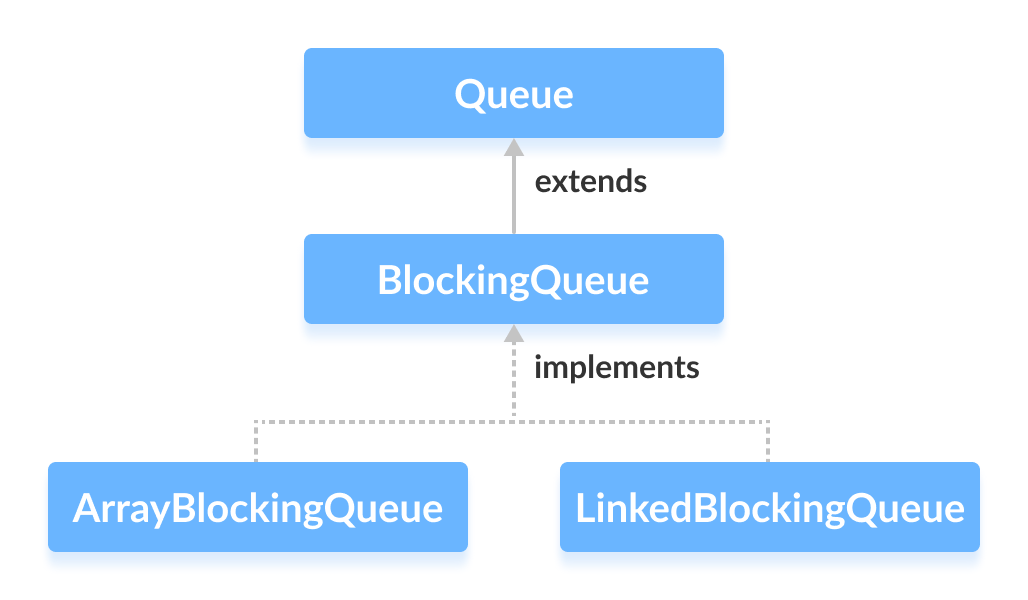(Java programming Example for Beginners)
Java LinkedBlockingQueue
In this tutorial, we will learn about the LinkedBLockingQueue class and its methods with the help of examples.
The LinkedBlockingQueue class of the Java Collections framework provides the blocking queue implementation using a linked list.
It implements the Java BlockingQueue interface.

Creating LinkedBlockingQueue
In order to create a linked blocking queue, we must import the java.util.concurrent.LinkedBlockingQueue package.
Here is how we can create a linked blocking queue in Java:
1. Without the initial capacity
LinkedBlockingQueue<Type> animal = new LinkedBlockingQueue<>();
Here the default initial capacity will be 231-1.
2. With the initial capacity
LinkedBlockingQueue<Type> animal = new LinkedBlockingQueue<>(int capacity);
Here,
- Type – the type of the linked blocking queue
- capacity – the size of the linked blocking queue
For example,
// Creating String type LinkedBlockingQueue with size 5
LinkedBlockingQueue<String> animals = new LinkedBlockingQueue<>(5);
// Creating Integer type LinkedBlockingQueue with size 5
LinkedBlockingQueue<Integer> age = new LinkedBlockingQueue<>(5);
Note: It is not compulsory to provide the size of the linked list.
Methods of LinkedBlockingQueue
The LinkedBlockingQueue class provides the implementation of all the methods in the BlockingQueue interface.
These methods are used to insert, access and delete elements from linked blocking queues.
Also, we will learn about two methods put() and take() that support the blocking operation in the linked blocking queue.
These two methods distinguish the linked blocking queue from other typical queues.
Insert Elements
add()– Inserts a specified element to the linked blocking queue. It throws an exception if the queue is full.offer()– Inserts a specified element to the linked blocking queue. It returnsfalseif the queue is full.
For example,
import java.util.concurrent.LinkedBlockingQueue;
class Main{
public static void main(String[] args){
LinkedBlockingQueue<String> animals = new LinkedBlockingQueue<>(5);
// Using add()
animals.add("Dog");
animals.add("Cat");
// Using offer()
animals.offer("Horse");
System.out.println("LinkedBlockingQueue: " + animals);
}
}
Output
LinkedBlockingQueue: [Dog, Cat, Horse]
Access Elements
peek()– Returns an element from the front of the linked blocking queue. It returnsnullif the queue is empty.iterator()– Returns an iterator object to sequentially access an element from the linked blocking queue. It throws an exception if the queue is empty. We must import thejava.util.Iteratorpackage to use it.
For example,
import java.util.concurrent.LinkedBlockingQueue;
import java.util.Iterator;
class Main{
public static void main(String[] args){
LinkedBlockingQueue<String> animals = new LinkedBlockingQueue<>(5);
// Add elements
animals.add("Dog");
animals.add("Cat");
animals.add("Horse");
System.out.println("LinkedBlockingQueue: " + animals);
// Using peek()
String element = animals.peek();
System.out.println("Accessed Element: " + element);
// Using iterator()
Iterator<String> iterate = animals.iterator();
System.out.print("LinkedBlockingQueue Elements: ");
while(iterate.hasNext()) {
System.out.print(iterate.next());
System.out.print(", ");
}
}
}
Output
LinkedBlockingQueue: [Dog, Cat, Horse] Accessed Element: Dog LinkedBlockingQueue Elements: Dog, Cat, Horse,
Remove Elements
remove()– Returns and removes a specified element from the linked blocking queue. It throws an exception if the queue is empty.poll()– Returns and removes a specified element from the linked blocking queue. It returnsnullif the queue is empty.clear()– Removes all the elements from the linked blocking queue.
For example,
import java.util.concurrent.LinkedBlockingQueue;
class Main{
public static void main(String[] args){
LinkedBlockingQueue<String> animals = new LinkedBlockingQueue<>(5);
animals.add("Dog");
animals.add("Cat");
animals.add("Horse");
System.out.println("LinkedBlockingQueue " + animals);
// Using remove()
String element1 = animals.remove();
System.out.println("Removed Element:");
System.out.println("Using remove(): " + element1);
// Using poll()
String element2 = animals.poll();
System.out.println("Using poll(): " + element2);
// Using clear()
animals.clear();
System.out.println("Updated LinkedBlockingQueue " + animals);
}
}
Output
LinkedBlockingQueue: [Dog, Cat, Horse] Removed Elements: Using remove(): Dog Using poll(): Cat Updated LinkedBlockingQueue: []
put() and take() Methods
In multithreading processes, we can use put() and take() to block the operation of one thread to synchronize it with another thread. These methods will wait until they can be successfully executed.
put() Method
To insert the specified element to the end of a linked blocking queue, we use the put() method.
If the linked blocking queue is full, it waits until there is space in the linked blocking queue to insert the element.
For example,
import java.util.concurrent.LinkedBlockingQueue;
class Main{
public static void main(String[] args){
LinkedBlockingQueue<String> animals = new LinkedBlockingQueue<>(5);
try {
// Add elements to animals
animals.put("Dog");
animals.put("Cat");
System.out.println("LinkedBlockingQueue: " + animals);
}
catch(Exception e) {
System.out.println(e);
}
}
}
Output
LinkedBlockingQueue: [Dog, Cat]
Here, the put() method may throw an InterruptedException if it is interrupted while waiting. Hence, we must enclose it inside a try..catch block.
take() Method
To return and remove an element from the front of the linked blocking queue, we can use the take() method.
If the linked blocking queue is empty, it waits until there are elements in the linked blocking queue to be deleted.
For example,
import java.util.concurrent.LinkedBlockingQueue;
class Main{
public static void main(String[] args){
LinkedBlockingQueue<String> animals = new LinkedBlockingQueue<>(5);
try {
//Add elements to animals
animals.put("Dog");
animals.put("Cat");
System.out.println("LinkedBlockingQueue: " + animals);
// Remove an element
String element = animals.take();
System.out.println("Removed Element: " + element);
System.out.println("New LinkedBlockingQueue: " + animals);
}
catch(Exception e) {
System.out.println(e);
}
}
}
Output
LinkedBlockingQueue: [Dog, Cat] Removed Element: Dog New LinkedBlockingQueue: [Cat]
Here, the take() method will throw an InterrupedException if it is interrupted while waiting. Hence, we must enclose it inside a try...catch block.
Other Methods
| Methods | Descriptions |
|---|---|
contains(element) |
Searches the linked blocking queue for the specified element. If the element is found, it returns true, if not it returns false. |
size() |
Returns the length of the linked blocking queue. |
toArray() |
Converts linked blocking queue to an array and return the array. |
toString() |
Converts the linked blocking queue to string |
Why use LinkedBlockingQueue?
The LinkedBlockingQueue uses linked lists as its internal storage.
It is considered as a thread-safe collection. Hence, it is generally used in multi-threading applications.
Suppose, one thread is inserting elements to the queue and another thread is removing elements from the queue.
Now, if the first thread is slower than the second thread, then the linked blocking queue can make the second thread waits until the first thread completes its operations.
Java tutorials for Beginners – Java LinkedBlockingQueue
Two Machine Learning Fields
There are two sides to machine learning:
- Practical Machine Learning:This is about querying databases, cleaning data, writing scripts to transform data and gluing algorithm and libraries together and writing custom code to squeeze reliable answers from data to satisfy difficult and ill defined questions. It’s the mess of reality.
- Theoretical Machine Learning: This is about math and abstraction and idealized scenarios and limits and beauty and informing what is possible. It is a whole lot neater and cleaner and removed from the mess of reality.
Disclaimer: The information and code presented within this recipe/tutorial is only for educational and coaching purposes for beginners and developers. Anyone can practice and apply the recipe/tutorial presented here, but the reader is taking full responsibility for his/her actions. The author (content curator) of this recipe (code / program) has made every effort to ensure the accuracy of the information was correct at time of publication. The author (content curator) does not assume and hereby disclaims any liability to any party for any loss, damage, or disruption caused by errors or omissions, whether such errors or omissions result from accident, negligence, or any other cause. The information presented here could also be found in public knowledge domains.

